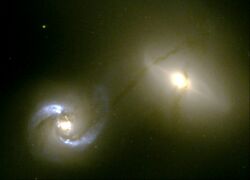Astronomy:NGC 1409
| NGC 1409 | |
|---|---|
 | |
| Observation data (J2000 epoch) | |
| Constellation | Taurus[1] |
| Right ascension | 03h 41m 10.546s[2] |
| Declination | −01° 18′ 10.12″[2] |
| Helio radial velocity | 7750±40 km/s[3] |
| Apparent magnitude (V) | 15.4[3] |
| Characteristics | |
| Type | SB0[4] or SAB pec[3] |
| Apparent size (V) | 1′.0 × 0′.8[3] |
| Notable features | Interacting with NGC 1410 |
| Other designations | |
| NGC 1409, UGC 2821, PGC 13553[5][3] | |
NGC 1409 is a quiescent[4] lenticular galaxy in the equatorial constellation of Taurus. It was discovered by the German-born astronomer William Herschel on January 6, 1785.[6] NGC 1409 is located in close proximity to the smaller Seyfert galaxy NGC 1410, and the two are strongly interacting. Their respective nuclei have a separation of just 23 kly, and they share a diffuse stellar envelope with a radius extending out to 49 kly.[4]
The morphological classification of this galaxy most closely matches type SB0, which indicates a barred lenticular galaxy. There is a conspicuous pipeline of dust and gas being funneled to NGC 1409 from NGC 1410. This lane has a typical width of 330 ly, passing to the north in front of NGC 1409 and then behind, becoming denser toward the galactic core. It has an estimated mass of 3×108 M☉ and is transferring mass at the estimated rate of 1.1–1.4 M☉ yr–1. However, there is no indications of recent star formation in NGC 1409 from this incoming material.[4]
References
- ↑ "HubbleSite - NewsCenter - Intergalactic 'Pipeline' Funnels Matter Between Colliding Galaxies". http://hubblesite.org/newscenter/archive/releases/2001/02/fastfacts/.
- ↑ 2.0 2.1 Skrutskie, Michael F.; Cutri, Roc M.; Stiening, Rae; Weinberg, Martin D.; Schneider, Stephen E.; Carpenter, John M.; Beichman, Charles A.; Capps, Richard W. et al. (1 February 2006). "The Two Micron All Sky Survey (2MASS)". The Astronomical Journal 131 (2): 1163–1183. doi:10.1086/498708. ISSN 0004-6256. Bibcode: 2006AJ....131.1163S. https://ui.adsabs.harvard.edu/abs/2006AJ....131.1163S/abstract.
- ↑ 3.0 3.1 3.2 3.3 3.4 "NASA/IPAC Extragalactic Database". Results for NGC 1409. http://nedwww.ipac.caltech.edu/.
- ↑ 4.0 4.1 4.2 4.3 Keel, William C. (March 2004). "Ongoing Mass Transfer in the Interacting Galaxy Pair NGC 1409/1410". The Astronomical Journal 127 (3): 1325–1335. doi:10.1086/381927. Bibcode: 2004AJ....127.1325K.
- ↑ "NGC 1409". SIMBAD. Centre de données astronomiques de Strasbourg. http://simbad.u-strasbg.fr/simbad/sim-basic?Ident=NGC+1409.
- ↑ Seligman, Courtney. "NGC Objects: NGC 1400 - 1449". https://cseligman.com/text/atlas/ngc14.htm#1409.
External links
 |

